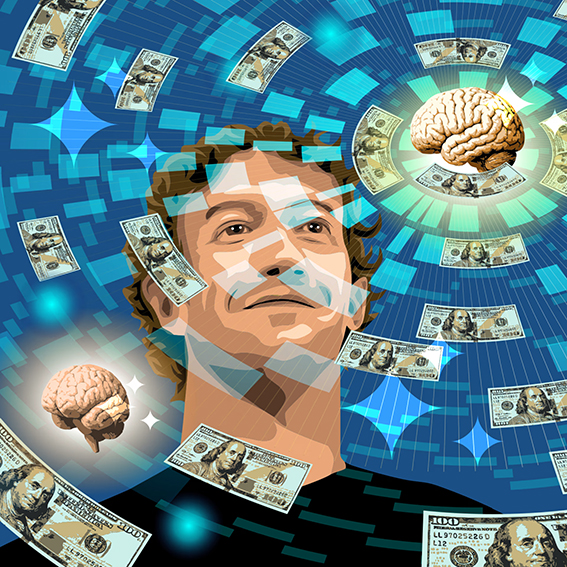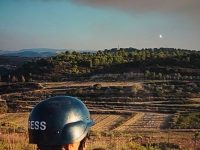It’s Known as ‘The List’—and It’s a Secret File of AI Geniuses

Only a select few researchers have the skills for the hottest area in tech. Mark Zuckerberg and his rivals want to hire them— even if it takes pay packages of $100 million.
All over Silicon Valley, the brightest minds in AI are buzzing about “The List,” a compilation of the most talented engineers and researchers in artificial intelligence that Mark Zuckerberg has spent months putting together.
Lucas Beyer works in multimodal vision-language research and describes himself as “a scientist dedicated to the creation of awesomeness.” Yu Zhang specializes in automatic speech recognition and barely has an online presence besides his influential papers. Misha Bilenko is an expert in large-scale machine learning who also enjoys hiking and skiing—or, as he puts it on his website, “applying hill-climbing search and gradient descent algorithms to real-world domains.”
The recruits on “The List” typically have Ph.D.s from elite schools like Berkeley and Carnegie Mellon. They have experience at places like OpenAI in San Francisco and Google DeepMind in London. They are usually in their 20s and 30s—and they all know each other. They spend their days staring at screens to solve the kinds of inscrutable problems that require spectacular amounts of computing power.
And their previously obscure talents have never been so highly valued.
The chief executives of tech goliaths and heavyweight venture capitalists are cozying up with a few dozen nerdy researchers because their specialized knowledge is the key to cashing in on the artificial-intelligence revolution.
Nobody in this rapidly escalating arms race is chasing the prized recruits quite like Zuckerberg, who has tried to raid Silicon Valley’s top research labs, dangling $100 million pay packages to a select few superstars with the hopes of poaching them.
The billionaire CEO of Meta wants them to join his company’s new lab focused on superintelligence, or AI that is smarter than humans, after the release of its latest model in April fell flat.
One recruit who has spoken with Zuckerberg, who is personally courting his dream team of potential hires, describes the company’s goal as nothing less than a “transfusion from the country’s top AI labs.”
The universe of engineers with deep experience pursuing this type of AI research is tiny. Their loyalty to each other transcends companies. As they decide whether to leave for Meta, they are comparing notes, trading intel and plotting their futures together. They’re trying to figure out who else is joining the lab—and who else is on “The List.” Some are teaming up as package deals. Others are negotiating lavish counteroffers to stay at their companies.
So who are these people—and why have some of the world’s richest companies decided they are worth so much?
Inside the secretive world
In the secretive world of building ever more powerful AI models, labs have begun to take drastic steps to protect their scientific breakthroughs.
At Anthropic and OpenAI, researchers work on separate, access-restricted floors, where the blinds are often drawn to guard against prying eyes. At Safe Superintelligence, the few candidates who secure in-person interviews are asked to leave their phone in a Faraday cage, a container that blocks cellular and Wi-Fi signals. Anthropic’s leaders became so worried that their researchers would be targets of foreign espionage that they once invited an agent from the Federal Bureau of Investigation to visit headquarters and describe the risks to employees.
The leader of Zuckerberg’s handpicked Superintelligence team is Alexandr Wang, 28, who grew up in New Mexico as the son of Chinese immigrant physicists at Los Alamos National Laboratory. He began making plans to create a company in the ninth grade, when he and a friend created a Google Doc of startup ideas. This month, Meta shelled out $14 billion for a stake in his company, Scale AI—and Zuckerberg made Wang one of the priciest hires of all time.
Meta has made offers to dozens of researchers at OpenAI. The startup has responded to Zuckerberg’s blitz with impressive packages of its own.
Not everyone on Meta’s list gets $100 million, though they’re still fetching astronomical sums.
One of Zuckerberg’s latest hires is a DeepMind alum and former OpenAI employee named Lucas Beyer. As a boy in Belgium, Beyer dreamed of making videogames and developed a fascination with AI. At college in Germany, he focused on mechanical engineering and dabbled in machine learning.
But when he applied for a job at Google as a software engineer more than a decade ago, he was rejected and decided to pursue a Ph.D.
At first, he studied quantum physics and learned something useful. “Quantum physics is just not my thing,” Beyer said on the AI Epiphany show. He made computer vision and robotic perception his thing instead. When he hit the job market in 2018, he’d done two summer internships at Google and, this time, the company offered him a job.
In fact, his talents were in such high demand that he received offers from all the industry’s top AI destinations—except one.
“Meta,” he said on that show. “I never heard back.”
These days, Beyer is hearing directly from Meta’s CEO.
After six years as a staff research scientist at Google Brain and DeepMind, Beyer left in 2024 to start OpenAI’s office in Zurich with two colleagues, Alexander Kolesnikov and Xiaohua Zhai.
Now they’re on the move again—because Zuckerberg just hired all three of them.
“Yes, we will be joining Meta,” Beyer wrote on X this week. “No, we did not get 100M.”
Perfectly timed Ph.D.s
With this spending bonanza and frenzy of movement, AI geeks are being treated more like NBA free agents. But in sports, there are easily accessible metrics that quantify the performance of star athletes, and people know exactly how much money their favorite players make—and whether they’re actually worth it.
It’s harder to measure the value of researchers whose work most people know precisely nothing about and couldn’t possibly understand.
There are some clues that help executives and recruiters assess talent. They can poke around Google Scholar and browse through the papers that researchers have published, checking to see how often their work has been cited.
Zuckerberg himself has been spending his days weeding through wonky papers, searching for hotshot engineers and scientists to recruit for his Superintelligence team of roughly 50 people. He’s in a group chat with two Meta executives called “Recruiting Party 🎉” in which they discuss hundreds of potential candidates and tactics for approaching them—like whether they prefer to be contacted by email, text or WhatsApp.
The people who get notes from Zuckerberg have a few things in common. They need to know calculus, linear algebra and probability theory, like one of Meta’s recent hires, who says he’s fascinated by algorithm design.
Advertisement
An undergraduate degree in computer science isn’t nearly enough training. These researchers get Ph.D.s from elite programs—Berkeley, Stanford, Carnegie Mellon, MIT—whose most selective fields admit less than 1% of applicants and have become a feeder system to AI labs.
Today’s researchers also had perfect timing. When many embarked on their Ph.D. work a decade ago, they were tackling esoteric topics in robotics and generative artificial intelligence. There was nothing remotely sexy about their fields. But they were exploring the frontier of AI—and their areas of interest have yielded revolutionary advances.
Zhang, a researcher at OpenAI who works on speech, was finishing up his first internship more than a decade ago when his mentor offered him some practical advice.
“You should not work on speech,” Zhang was told, he recounted to Carnegie Mellon students last year. “This is a dead field.” That mentor soon left for Yahoo to work on ads.
A few months later, the seemingly dead field was resuscitated by advances in deep learning, which created a new way for computers to analyze and understand speech patterns. Now, Zhang is the sort of engineer that every lab covets—and Zuckerberg has reached out to him.
One reason all these companies are willing to shower recruits with cash is that even a superteam of AI engineers costs only a fraction of the price of AI infrastructure like data centers.
This year alone, Meta plans to invest around $70 billion on AI, while Amazon, Microsoft and Alphabet are spending even more. Next to hardware, humans look like a bargain.
People in the tight-knit AI community say the researchers whose skills have never been so lucrative are not primarily motivated by huge piles of money.
Until recently, many were perfectly happy to become professors. These days, they’re becoming researchers at AI labs—but not just because of the pay. It’s because only tech companies with seemingly limitless resources offer the computing power, data, infrastructure and freedom they need to run their experiments and scale their models.
“For my students and postdocs, the objective was never to do hot things and become a millionaire,” said Alexei Efros, a University of California, Berkeley, professor whose recent Ph.D. students include research scientists at OpenAI, DeepMind and Anthropic. “The objective is to try to solve cool, interesting, important, unsolved problems.”
Those problems require money and chips. Meta, OpenAI and Google have both in abundance.
But to win recruiting battles, top executives also have to get involved themselves.
OpenAI CEO Sam Altman has invited potential hires to play poker or have dinner with him at his Russian Hill mansion in San Francisco, while President Greg Brockman used to host “Game of Thrones” watch parties. Elon Musk once hosted a recruiting party at OpenAI’s former headquarters to entice researchers into joining xAI. At Google, CEO Sundar Pichai and co-founder Sergey Brin carve out time to bring over important hires.
AI’s ‘tribal knowledge’
The eight- and sometimes nine-figure pay packages are tempting, and the outreach from Zuckerberg is flattering, but Meta’s laggard history in generative AI has made some recruits hesitant. When the company released its latest model to little fanfare, some researchers at Meta distanced themselves from the model, removing the project, called Llama 4, from their LinkedIn bios.
Zuckerberg hasn’t had much success in his efforts to hire the field’s biggest stars, including OpenAI’s co-founder Ilya Sutskever and its chief research officer, Mark Chen.
Many candidates are happy to take a meeting at Zuckerberg’s homes in Palo Alto and Lake Tahoe. In private, they are comparing gossip and calculating Meta’s chances of winning the AI race.
The handful of researchers who are smartest about AI have built up what one described as “tribal knowledge” that is almost impossible to replicate. Rival researchers have lived in the same group houses in San Francisco, where they discuss papers that might provide clues for achieving the next great breakthrough.
When a Ph.D. student at Berkeley named Bill Peebles submitted his dissertation in 2023, he thanked another Ph.D. candidate named Tim Brooks.
“We are very aligned on research directions and interests,” he wrote. “I hope we get to work on more stuff together in the future.”
As it turned out, they would. Peebles and Brooks both went to work for OpenAI and led the team that released its groundbreaking Sora text-to-video generator in 2024. Brooks has since left for DeepMind, while Peebles is still at OpenAI—even after Meta recently tried to hire him.
And then Zuckerberg moved on to the next person on “The List.”
Write to Ben Cohen at ben.cohen@wsj.com, Berber Jin at berber.jin@wsj.com and Meghan Bobrowsky at meghan.bobrowsky@wsj.com










